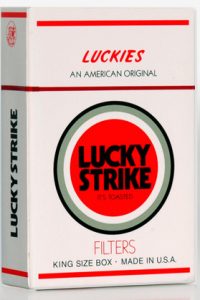


But in men’s club fashion they also made fun of their own ludicrous stereotypes. They ran the agencies, produced the images, and wrote the copy that created the commercially correct woman. Men also played a role in cigarette advertising for women. Camels asserted that “Smokers everywhere are turning to Camels for their delightful ‘energizing effect’ … Camels never get on your nerves.” Lucky Strike took the homeopathic route with their motto, “It’s toasted.” A typical ad read “Everyone knows that sunshine mellows-that’s why the ‘toasting’ process includes the use of Ultra Violet Rays …Įveryone knows that heat purifies and so ‘toasting’-that extra secret process-removes harmful irritants that cause throat irritation and coughing.” By the late 1930s Lucky Strike had added the following tagline to its motto: “sunshine mellows-heat purifies.” To deflect public attention away from what the industry viewed as minor physical ailments, cigarette advertising exploited certain perceived health benefits, including increased vigor and stamina. Even tobacco manufacturers acknowledged that frequent product usage resulted in coughing, throat irritation, and rasp-sounding voices. Yet despite the claim of weight control, they offered no viable health inducements. We do declare that when tempted to do yourself too well, if you will ‘Reach for a Lucky’ instead, you will thus avoid over indulgence in things that cause excess weight and, by avoiding over indulgence maintain a modern, graceful form.”Ĭigarettes were a staple for Depression-weary and later war-torn Americans. If you would maintain the modern figure of fashion.” Under an idealized color painting of a young woman haunted by the shadow of a double chin, the copy read: “We do not represent that smoking Lucky Strike Cigarettes will bring modern figures or cause the reduction of flesh. “Avoid that future shadow,” the copy suggested, “by refraining from over indulgence. High culture was used in one sales pitch that borrowed Henry Wadsworth Longfellow’s “First a Shadow Then a Sorrow” to announce Lucky Strike’s diet plan. Using smoke and mirrors, cigarette advertising suggested the promise of a better life.Īdvertising wizards also made cigarettes seductive to women by invoking the ideal. Cigarettes were marketed as fashion accessories, but these ads, which ran during the Great Depression, were not targeted exclusively to women of means. In the haughty “I do” advertisement a sultry bride pauses for a relaxed smoke and gives her vow to the cigarette of choice. In “OK – Miss America! We thank you for your patronage” a woman wearing a revealing, low-cut satin gown is so above the fray that she isn’t even holding a Lucky, but the implication is that she had just finished a satisfying smoke.
LUCKY STRIKE ITS TOASTED SERIES
To promote the image of sophistication, a series of 1930s magazine ads featured stylized paintings of women decked out in evening finery. No expense was spared by Lucky Strike in recruiting female customers. And if women were going to smoke, reasoned the tobacco industry, then why not encourage them to smoke a lot? By 1910 advertisements hinted that smoking was a right-and by the 1920s it was a duty. On the way to achieving first-class citizenship, women became first-class tobacco consumers. Taken up as a cause célèbre, women’s right to cigarettes was a smokescreen in the struggle for more fundamental rights. Women have come a long way from the pre-suffrage era when it was unladylike to smoke.


 0 kommentar(er)
0 kommentar(er)
